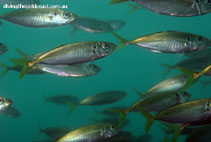| Family: |
Carangidae (Jacks and pompanos), subfamily: Caranginae |
| Max. size: |
50 cm SL (male/unsexed); max. reported age: 25 years |
| Environment: |
pelagic-oceanic; brackish; marine; depth range 22 - 500 m |
| Distribution: |
Southwest Pacific: Australia and New Zealand waters. Two subpopulations probably exist in the Great Australian Bight and southeastern Australia, respectively, and two species or subspecies in the southeastern group (Ref. 7456). |
| Diagnosis: |
Dorsal spines (total): 9-9; Dorsal soft rays (total): 27-33; Anal spines: 3-3; Anal soft rays: 22-29; Vertebrae: 24-24. Adults are elongate and compressed, and have a primary lateral line with 67-81 scutes, a secondary lateral line reaching to dorsal-fin ray 2, and a yellow caudal fin. |
| Biology: |
Adults occur in coastal waters, including estuaries (Ref. 9563), mostly in waters shallower than 150 m and warmer than 13°C (Ref. 9072). Commonly found on the bottom, in midwater and occasionally at the surface (Ref. 9258), in large schools (Ref. 33616). Adults are generally found over offshore rocky reefs, while juveniles are generally found in shallow, soft substrate areas (Ref. 6390). Utilized fresh, smoked, canned and frozen; can be fried, broiled and baked (Ref. 9988). |
| IUCN Red List Status: |
Least Concern (LC); Date assessed: 17 July 2017 Ref. (130435)
|
| Threat to humans: |
harmless |
Source and more info: www.fishbase.org. For personal, classroom, and other internal use only. Not for publication.
